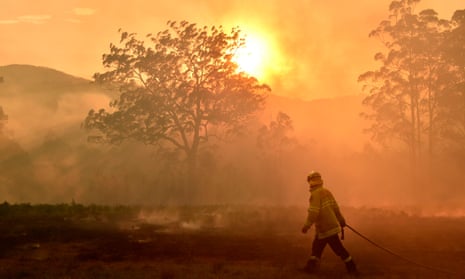New South Wales residents have been urged to prepare for the impending bushfire season, with three wet years and high vegetation growth possibly giving way to a dry El Niño summer.
Fire chiefs warn a level of bushfire complacency has crept into the community in many parts of the state, including in areas inundated by flooding and regions unaffected by the 2019/20 black summer bushfires.
Firefighters are preparing for a warmer and drier summer with high fuel loads after three consecutive years of La Niña, a weather event that is driven by ocean temperatures and usually entails wetter and cooler conditions.
With parts of the northern hemisphere in the grips of extreme heatwaves, overseas weather bodies such as the World Meteorological Organization have declared the converse El Niño phenomenon is now under way.
The Bureau of Meteorology (BoM) forecasts hotter and drier conditions across most of Australia this spring, although it is yet to upgrade its El Niño forecast beyond “alert” status.
Catherine Ganter, a senior meteorologist at BoM, on Tuesday said the threshold for an El Niño event was different in every country and it was too soon to make the call in Australia.
“The bureau’s latest long-range forecast for August to October shows drier than average conditions are likely for much of Australia,” she said.
While the outlook for the upcoming fire season is yet to be settled, the NSW Rural Fire Service is warning residents to get ready.
RFS inspector Ben Shepherd said the season would start as soon as next month in parts of the state and residents needed to be taking their safety into their own hands.
“Whilst we’ll do as much as we can, homeowners need to ensure that they’re prepared as well because there will come a day that won’t have a firefighter or a plane or a truck there,” he said.
“We’re wanting those that live and work in areas that weren’t burned during the 2019/20 fire season to consider their risk.”
The warnings come after the head of Fire and Rescue NSW, Paul Baxter, was fired after six years in the job. The premier, Chris Minns, defended the decision of the emergency services minister, Jihad Dib, to seek a “fresh direction”.
“He decided that a fresh direction was warranted,” Minns said.
Minns said it would make sense for the agency to spend more on permanent positions and less on overtime wages.
“We need to make sure that we’re recruiting firefighters,” he said.
Last year there were 3,579 permanent firefighters in the agency and a further 3,243 employed on call.
after newsletter promotion
The state’s lead bushfire agency, the RFS, has about 72,000 volunteers – down from 76,319 in 2019/20.
The NSW Forestry Corporation’s state fire manager, Rebel Talbert, said government agencies had started preparing for a “busier” bushfire season after three back-to-back La Niña years resulted in “prolific” grass growth.
“It’s really about the grass fuel loads, that’s obviously covering large parts of the state,” Talbert said.
“Fires can move very quickly in grass and that’s our main concern for this fire season.”
Former Fire and Rescue NSW commissioner Greg Mullins is also expecting bushfires this summer given Australia’s east coast has historically experienced an active season after every triple La Niña event.
Mullins said NSW could experience intense fires such as those that destroyed homes after the previous three consecutive La Niña years in 1957, 1977 and the 2001-2002 summer.
“In Sydney we’ve had the driest start to winter in decades. We’re way below the average rainfall in July so far,” Mullins said.
“We’re getting little bouts of rain which has taken away our main preventative tool of hazard reduction burning. Because if it’s wet, nothing burns. So we’ve got a three-year backlog.”
Mullins warned the Lower Hunter, Newcastle, Central Coast and Illawarra areas were most at risk because they “weren’t really touched” by the black summer fires.
Flood-affected areas of NSW would also be at increased risk of fires this summer, he said.
